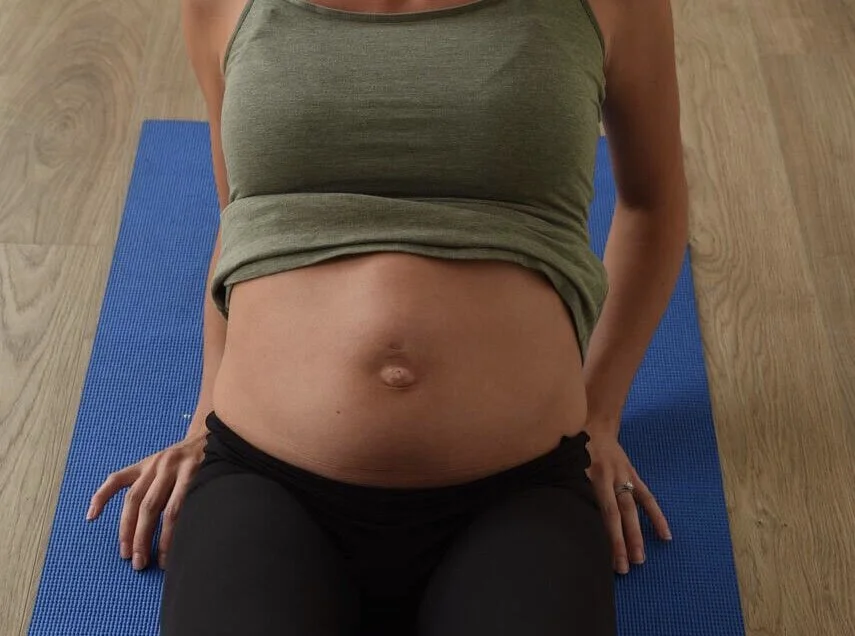Core training, abdominal doming & safe exercise
It’s important to understand your body and know what is safe exercise for when you’re pregnant.
If you’re pregnant or if you’ve recently given birth then your core muscles are super important! We need to avoid exerting too much pressure onto the midline of your abdominals. The midline connective tissue is called the linea alba.
This pressure is known as intra abdominal pressure which isn’t great for your abdominals or your pelvic floor.
There are certain exercises which need to be avoided
If you’re pregnant or you’ve recently given birth then the following exercises need to go out of the window: planks, sit ups, crunches, double leg lifts.
High impact exercises like running, jumping and HITT classes aren’t great either.
I will go on to tell you which exercises I recommend but first I will explain a little bit about the anatomy of the abdominals and doming.
Your abdominal wall is made out of three distinctive layers:
Your first layer is your rectus abdominis (‘six-pack’ muscle). Your rectus is classified as your outer core and is a powerful muscle that flexes your trunk, such as when you crunch to get out of bed.
Your second abdominal layer, your obliques, is also a part of your outer core, and is responsible for trunk rotation, such as when you turn to look over your shoulder.
Lastly is your transverse abdominis muscle (TA), which makes up the third and deepest layer of your abdominal wall and is referred to as your “deep or inner core”. This muscle provides you with subtle support all day long, it allows you to sit, stand for longer periods of time without getting pain in your hips or back. Your TA also contributes to the contour of your tummy.
The transversus abdominis (TA) is such an important muscle when it comes to preventing and/or treating diastasis recti (abdominal separation), back pain and pelvic floor dysfunction.
When exercising we need to focus on contracting this muscle.
Locating your Transverse Muscle
Lay on your back with your knees bent, place your fingertips between your hip bones and cough. That contraction you feel is your TA muscle.
A well-functioning TA helps to prevent and/or treat abdominal doming (also referred to as coning), which commonly occurs in the later stages of pregnancy and in the early postnatal period. Preventing abdominal doming reduces the risk of excessive or prolonged abdominal separation.
When your TA contracts it pulls your linea alba (midline connective tissue) taut. By pulling your linea alba taut it prepares your abdominal wall for loading, allowing your outer core to transmit/generate force, and prevents the linea alba from pushing out down the middle (abdominal doming).
Abdominal Doming
As previously mentioned, abdominal doming commonly occurs in the later stages of pregnancy and in the early postnatal period.
Avoiding/minimising abdominal doming pre and postnatally is extremely important to protect your linea alba. Repeated doming can result in over stretching of the linea alba making the connective tissue thin.
If you’re exercising and you see doming then you must stop what you’re doing, modify the exercise or avoid it completely!
Also be mindful of how you get up out of bed or up from the floor. I’d advise rolling onto your side first before getting up, this will reduce the strain placed onto the linea alba.
If the linea alba loses its tautness and ability to pull back in then this can result in prolonged or excessive diastasis postnatally.
Rehabilitating your TA may not only help to prevent abdominal doming in pregnancy but can also help to tighten and thicken up your linea alba postnatally.
This is why the TA is so important when it comes to preventing and treating diastasis recti.
If you experience back/pelvic girdle/hip pain, pelvic floor dysfunction, abdominal doming or have tummy muscle separation I strongly advise you to visit a female health physiotherapist.
Safe exercises - pregnancy
Always focus on your breathing. Exhale on the hardest part of the movement. As you exhale, think of drawing in your abdominal muscles and on the inhale relax and release.
Shoulder taps - https://youtube.com/shorts/d6vTDCLGcLA?feature=share
Pall off presses - https://youtube.com/shorts/7ukvLyneYYU?feature=share
Bird dog - https://youtu.be/4K8yGD4eYWk
Arm raises - https://youtube.com/shorts/4zoleWkOSPo?feature=share
Safe exercises - postnatal
Always focus on your breathing. Exhale on the hardest part of the movement. As you exhale, think of drawing in your abdominal muscles and on the inhale relax and release.
Toe taps single - https://youtu.be/CRzDabSvP7s
Toe taps double - https://youtube.com/shorts/c1J2s0R-KIE?feature=share
Deadbug - https://youtu.be/CPVARyjHGao
Pall off presses with overhead extension - https://youtube.com/shorts/QEO7T93SYGo?feature=share
Bird dog knee to elbow - https://youtu.be/tt6uczbYJME

